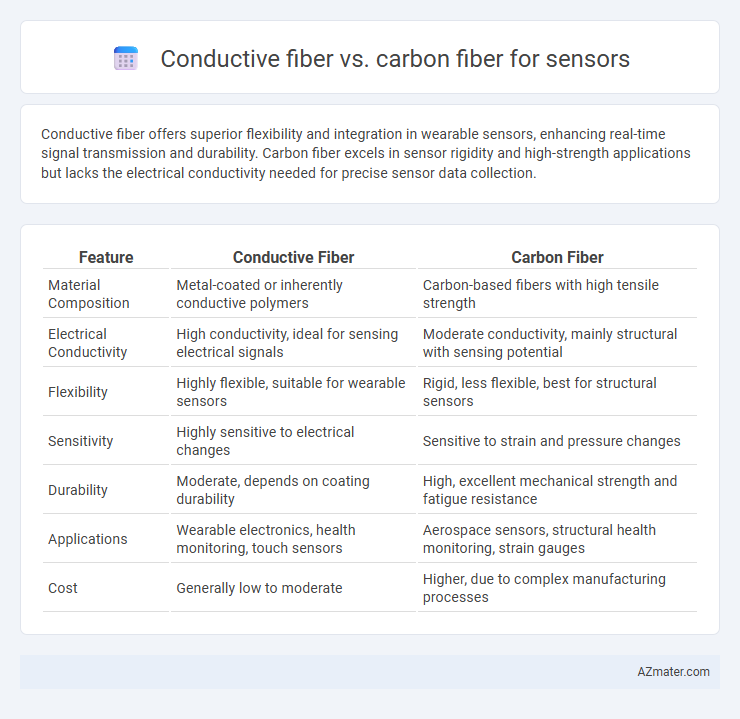Conductive fiber offers superior flexibility and integration in wearable sensors, enhancing real-time signal transmission and durability. Carbon fiber excels in sensor rigidity and high-strength applications but lacks the electrical conductivity needed for precise sensor data collection.
Table of Comparison
| Feature | Conductive Fiber | Carbon Fiber |
|---|---|---|
| Material Composition | Metal-coated or inherently conductive polymers | Carbon-based fibers with high tensile strength |
| Electrical Conductivity | High conductivity, ideal for sensing electrical signals | Moderate conductivity, mainly structural with sensing potential |
| Flexibility | Highly flexible, suitable for wearable sensors | Rigid, less flexible, best for structural sensors |
| Sensitivity | Highly sensitive to electrical changes | Sensitive to strain and pressure changes |
| Durability | Moderate, depends on coating durability | High, excellent mechanical strength and fatigue resistance |
| Applications | Wearable electronics, health monitoring, touch sensors | Aerospace sensors, structural health monitoring, strain gauges |
| Cost | Generally low to moderate | Higher, due to complex manufacturing processes |
Introduction to Sensor Materials: Conductive Fiber vs Carbon Fiber
Conductive fibers, composed of materials like silver-coated polymers or stainless steel blends, offer high flexibility and excellent electrical conductivity ideal for wearable sensors and flexible electronics. Carbon fibers provide superior strength-to-weight ratios and chemical stability, making them suitable for structural sensors in aerospace and automotive applications. Both materials enable efficient signal transmission but differ significantly in mechanical properties and integration methods depending on sensor design requirements.
Defining Conductive Fibers: Types and Properties
Conductive fibers, including metal-coated, carbon-based, and intrinsically conductive polymer fibers, exhibit electrical conductivity essential for sensor applications. Unlike carbon fiber, which primarily offers high strength and stiffness with moderate conductivity, conductive fibers provide tailored electrical properties enabling precise signal transmission and sensitivity in wearable and flexible sensors. These fibers combine mechanical flexibility with electrical conductivity, enhancing sensor performance in detecting strain, pressure, and bioelectric signals.
Understanding Carbon Fiber: Structure and Electrical Conductivity
Carbon fiber consists of tightly packed carbon atoms arranged in a crystalline structure that provides exceptional strength and lightweight properties. Its electrical conductivity arises from the delocalized electrons within the graphitic planes, enabling efficient electron flow. This intrinsic conductivity makes carbon fiber ideal for sensor applications where precise electrical signal transmission and responsiveness are critical.
Comparative Electrical Performance in Sensor Applications
Conductive fiber typically offers higher flexibility and better tensile strain sensitivity compared to carbon fiber, making it ideal for wearable sensor applications requiring dynamic deformation detection. Carbon fiber exhibits superior electrical conductivity and stability under static conditions, which enhances signal reliability in fixed-position sensors. The choice between conductive fiber and carbon fiber depends on the sensor's mechanical demands and electrical performance requirements, with conductive fibers excelling in stretchability and carbon fibers in consistent conductivity.
Sensitivity Differences: Conductive Fiber vs Carbon Fiber Sensors
Conductive fiber sensors exhibit higher sensitivity due to their continuous conductive pathways, enabling precise detection of subtle strain or pressure changes. In contrast, carbon fiber sensors rely on changes in electrical resistance caused by fiber alignment shifts, offering moderate sensitivity but superior mechanical strength. The choice between conductive fiber and carbon fiber sensors depends on the required balance between sensitivity and structural integrity in specific sensing applications.
Durability and Mechanical Strength Analysis
Conductive fibers exhibit higher flexibility and fatigue resistance, making them ideal for sensors subjected to repeated mechanical stress, while carbon fibers provide superior tensile strength and stiffness, enhancing durability under heavy loads. Mechanical strength analysis demonstrates carbon fibers maintain structural integrity over longer periods in harsh environments, but conductive fibers outperform in applications requiring consistent electrical conductivity combined with moderate durability. Optimal sensor design involves balancing the lightweight, high-strength properties of carbon fibers with the electrical and fatigue resilience of conductive fibers to achieve both durability and reliable performance.
Compatibility with Wearable Sensor Technologies
Conductive fibers offer superior flexibility and skin compatibility, making them ideal for integration with wearable sensor technologies that require comfort and stretchability during movement. Carbon fibers provide excellent electrical conductivity and mechanical strength but are less flexible, which can limit their compatibility with soft, form-fitting wearable sensors. Wearable devices benefit from conductive fibers' ability to maintain signal integrity under deformation, enhancing real-time physiological monitoring accuracy.
Cost-Effectiveness and Scalability for Sensor Manufacturing
Conductive fibers offer superior cost-effectiveness compared to carbon fibers due to lower raw material prices and simpler manufacturing processes, making them ideal for large-scale sensor production. Carbon fibers provide higher sensitivity and durability but involve more complex fabrication and greater expense, limiting scalability for mass sensor manufacturing. Manufacturers seeking scalable and affordable sensor solutions often prioritize conductive fibers to balance performance and production efficiency.
Environmental Impact and Sustainability Considerations
Conductive fibers, often made from metal-coated polymers or intrinsically conductive polymers, tend to have a lower environmental impact due to their potential for recycling and less energy-intensive production compared to carbon fibers, which require high-temperature processes and result in significant CO2 emissions. Carbon fibers, known for their strength and lightweight properties, pose sustainability challenges due to difficulties in recycling and disposal, often ending up in landfills or requiring energy-demanding recovery methods. Choosing conductive fibers for sensors can enhance sustainability by reducing carbon footprint and facilitating end-of-life material recovery, aligning with environmentally conscious manufacturing practices.
Future Trends in Sensor Innovation: Conductive Fiber or Carbon Fiber?
Future trends in sensor innovation highlight the growing adoption of conductive fibers due to their exceptional flexibility, lightweight properties, and integration capabilities within wearable electronics. Carbon fibers offer superior mechanical strength and high electrical conductivity, making them ideal for robust, high-precision sensor applications in aerospace and industrial sectors. Advancements in hybrid composite materials combining conductive fiber and carbon fiber promise enhanced sensitivity, durability, and multifunctionality, driving next-generation sensor technologies.

Infographic: Conductive fiber vs Carbon fiber for Sensor
 azmater.com
azmater.com